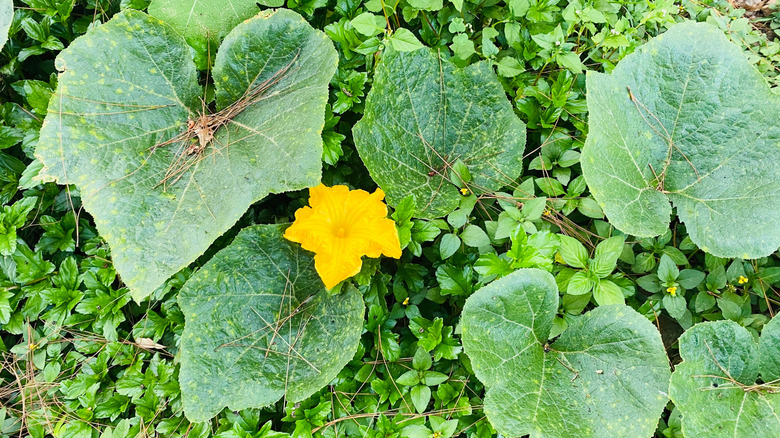Give Your Garden A Brand-New Look With The Help Of A Rotting Pumpkin. Here's How
If you have rotting pumpkins starting to ruin your front porch aesthetic, there's a way to get rid of them that's much more fun and fulfilling than tossing them into the garbage — and better for the planet. When these pumpkins end up in the landfill, their decomposition process can create the harmful greenhouse gas, methane. Plus, you'll miss out on a valuable opportunity to grow something new. If you want to try your hand at growing your own pumpkins, just toss that decaying pumpkin in your yard or bury it in the garden. As it continues to decompose, it will naturally fertilize the soil, creating a nice healthy bed for the seeds to germinate in. Come next spring, you might just see a vine pop up and little pumpkins begin to grow.
While there is no guarantee that burying your pumpkin in this way will ensure that new pumpkins grow in the spring, there is plenty of anecdotal evidence that it could happen. People have done it by smashing the pumpkins into the ground and covering them lightly with soil. Others have simply placed the pumpkin in a back corner of their yard and left it to decompose on its own, the seeds scattered by wildlife. Various types of pumpkins grow can grow using these methods, with vines emerging as the weather warms up the following season. If you have the space in your garden, planting a rotting pumpkin might be worth a try!
Rotting pumpkins can enrich soil and sprout new vines
If you toss a rotting pumpkin into your garden, there's a chance new pumpkins will grow naturally. But if you want a more reliable means of sprouting a vine, there is another method to successfully grow pumpkins from harvested seeds. Begin by removing the seeds from the pumpkin and cleaning them off. Lay them out to dry, using wax or parchment paper so they don't stick. Store them in a paper envelope, in a cool, dry place. Store the seeds until two weeks after the last frost before planting them. This will give your future pumpkin patch a much better chance of success. After removing the seeds, don't throw out the rotting pumpkin; add it to the compost pile! Pumpkin flesh releases nutrients like potassium, boron, nitrogen and phosphorous, which are excellent for growing leafy greens.
This method can work for several types of pumpkins. The Connecticut field pumpkin, Cucurbita pepo, is the type of pumpkin you most often find around halloween, and is one of the best types of pumpkins for seed saving. They are tender annuals and easy to care for. When the soil has warmed, mix in some of your own DIY compost and plant the seeds 1 to 1.5 inches deep. Plant about four or five seeds per row, leaving 3 to 4 feet between seeds and 4 to 8 feet between rows. Water the seedlings deeply but infrequently, about 1 to 2 inches per week. The pumpkins will mature 45 to 55 days after flowering and should be harvested with the stem attached.

